How the Integrated Crisis Team is collaborating in a groundbreaking effort to address services.
| 2019 Q4 | story by Emily Mulligan | photos by Steven Hertzog
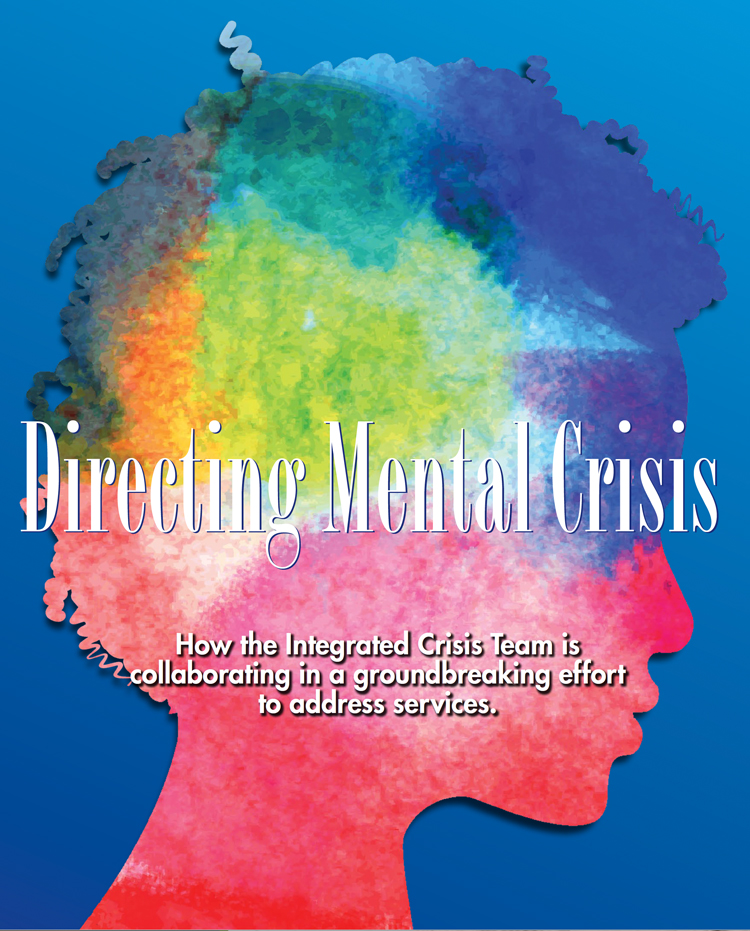
The Monopoly card phrasing is “Do not pass go. Do not collect $200,” when the player must go directly to a spot on the board. In the realm of addiction treatment, it isn’t quite worded that way, but when a person in the throes of addiction requests help, it is best to act on that request¬ immediately and without detours – before the person changes their mind.
Until recently, addicts who presented in the Emergency Department at LMH Health and asked for help with detoxification or rehabilitation could receive referrals but no immediate assistance and certainly no financial help or transportation help to check into facilities.
That changed drastically in early 2018 when the Emergency Department’s behavioral health team, the Integrated Crisis Team (ICT), began collaborating with multiple area agencies in a groundbreaking effort to provide supportive, seamless transfers directly from LMH to area detox facilities for patients who requested it. Using county funds to help patients pay detox costs, DCCCA, Heartland RADAC (Regional Alcohol & Drug Assessment Center), Bert Nash and LMH concocted a plan to place non-medical staff in the ER dedicated to counseling substance abusers about how to get help, should they choose to.
The care model, to be used for patients who qualified for non-medical detox, known as “social detox,” was a novel approach to social detox but combined some best practices from mental health and addiction treatment. Quite literally, the patients were to be met where they were – in the Emergency Department – and provided with on-the-spot counseling from a peer who had “lived experience” with addiction recovery. From there, the peer support could locate a social detox facility, give the patient a ride directly to that facility (most are outside Douglas County) and secure payment for the process through Douglas County funds earmarked for behavioral health or the patient’s health insurance coverage.
“We know that treatment is effective and that people recover. But you have to have a system in place,” says Bob Tryanski, Douglas County’s director of behavioral health projects.
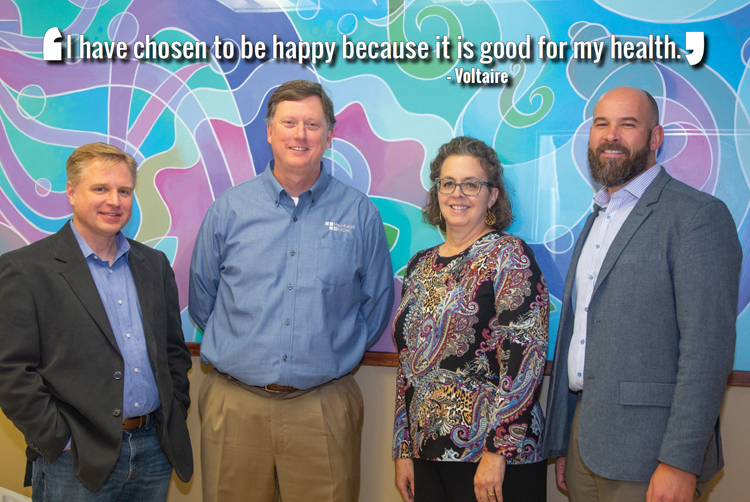
L-R: Bob Tryanski, Director of Behavioral Health Projects; Jason Hess Executive, Director Heartland RADAC; Sandra J. Dixon, Director of Behavioral Health Services; Derrick Hurst Director, Integrated Crisis Team Lawrence Memorial Hospital
MENTAL HEALTH FUNDING IN DOUGLAS COUNTY
The social detox program was active before the November 2018 vote in which voters approved a ¼-cent sales tax to fund a behavioral health campus, which will be constructed north of Bert Nash and LMH, in the 1000 block of West 2nd St.. A previous proposal for a mental health campus, which controversially was tied to expansion of the Douglas County Jail, failed in a 2016 vote.
Tryanski says that the county and other entities had a pressing need to serve the mental health challenges facing the community, in spite of the lack of a comprehensive facility, so the agencies forged ahead with other possibilities before the 2018 vote.
In January 2018, the Integrated Crisis Team formed to oversee the five-bed Emergency Department unit at LMH Health dedicated to behavioral health. Now headed by Derrick Hurst, who started in March 2018, the unit is staffed by nurses, doctors and master’s-level behavioral health professionals who consult patients who are suicidal, are experiencing a mental health episode and/or who have addiction challenges.
Tryanski says that the ICT represents embracing the fact that mental health patients show up in the ER and need help at all hours, as opposed to forcing those people to seek help from agencies that only operate in the traditional work week.
“We’re trying to change the culture in the ER. Now we send the message to patients that, ‘You’re exactly where you should be, and we’ll get you to the help you need,’” he says.
He says that eventually, he hopes the behavioral health campus, when it is completed in 2021, will serve as the “front door” for people experiencing mental illness. In the meantime, the Lawrence-Douglas County Health Department has embarked on detailed data collection from the ICT’s experience, to ensure that plans for the campus will reflect the county’s actual needs. Also, there have been four psychiatrists hired to the area in the past 18 months, to bolster the community’s response to mental health needs.
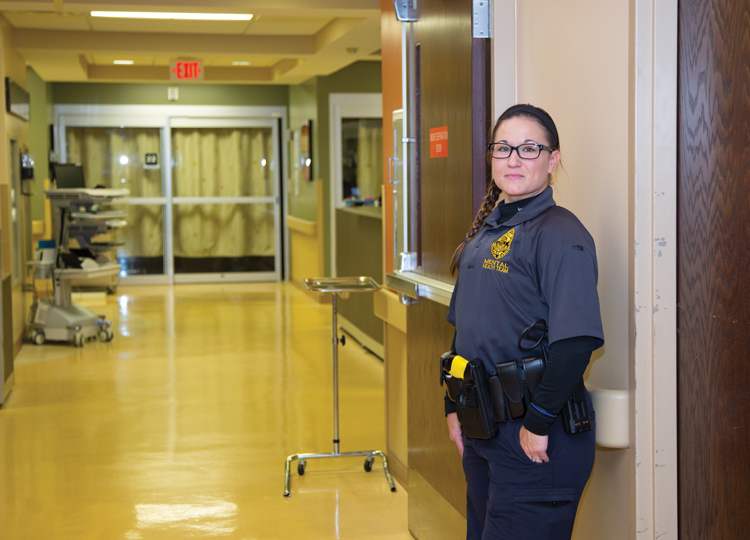
Officer Amber Rhoden, Lawrence Police Department Mental Health Team works closely with the Behavioral Health Crisis Team as they can be the first contact for individuals in our community who may be experiencing a behavioral health crisis.
DISMANTLING BARRIERS TO DETOX
Prior to the ICT, patients often missed the window of opportunity for social detox, because even with the best of intentions, ultimately they left the ER and resumed their normal patterns.
“The problem was that there were too many barriers to getting people to start recovery who wanted to go,” ICT Director Hurst says. “There were barriers getting them to say ‘yes,’ to finding a place they could go, and they didn’t have the resources to get there.”
Although securing transportation and financial assistance keeps the patient moving in the recovery process, Hurst says that the peer supports in the ER have made the biggest impact on patients opting to go for social detox.
“Now, we have someone who can come and sit down and actually talk to the patient, while the Emergency Department staff fulfills its medical duties. The peer has lived experience in addiction recovery and knows what to say and do,” Hurst says.
OPTING INTO SOCIAL DETOX
Here is how the process works, from arriving in the ER under the influence of a substance to taking up the offer of social detox and beginning the rehabilitation process.
Once the Emergency staff has stabilized the patient medically and determines that they could be a candidate for social detox, the patient is moved to the ER’s behavioral health unit (if they aren’t already there). A social worker or behavioral health consultant contacts DCCCA to request a peer support so that the peer can discuss the idea of social detox with the patient.
“It’s one thing for a medical professional or social worker to say, ‘I recommend you detox.’ A peer support can say from their own experience, ‘It’s not that scary.’ The patient listens to the peer and can say, ‘This person is like me and there is hope because of them,’” says Sandra Dixon, director of behavioral health services for DCCCA.
Patients can begin to see themselves reflected in the peer support as they recuperate from the worst of the crisis in the ER.
“The peers are there to amplify the patient voice in the treatment process. They become a valuable part of the treatment team,” Hurst says.
Social detox takes about two to four days, during which people must be in a safe place and have access to hydration and healthy food. Douglas County only has two beds where patients can do social detox, and both of those are for women, at First Step at Lakeview, if the beds are open. Male patients – and female patients when First Step is full – must leave the county and go to a facility in Johnson County, Kansas City, Kan., Topeka or even as far as Wichita.
“When you look at the peer support fellowship program, that is the embodiment of the work that we do. These people have been through the systems and recovery, and now they get to give back a little bit and help people do the same thing,” says Jason Hess, executive director of Heartland RADAC.
The peer arrives at the ER prepared to make arrangements at a social detox facility and transport the patient. This is the point where the Monopoly refrain comes into play. The peer brings clothing and personal hygiene items so that the patient can leave straight from LMH with everything they need for their detox experience.
“We try to coordinate it all to be quick. Every time there is a stop, there is an opportunity for that person not to go ahead with recovery. We use the time well: What happens in the car is important with the peer support, because they continue the message of offering hope,” Dixon says.
Once the patient is settled in the social detox facility and begins to feel better after a day or two, a Heartland RADAC care coordinator pays them a visit.
“At detox, the care coordinator asks people what they want to accomplish. Often, that is one of the first times they get asked that question. When you ask and start there, they have a stake in the game,” Hess says. “It is pretty rare that they don’t want to do something different.”
The Heartland RADAC care coordinators can arrange for the patient to go to a rehab facility either in Kansas or away, the patient’s choice. Rehab paperwork can get started in the field to help speed up the process, should the patient choose rehab. Typically, patients return home for some interval between detox and rehab, because they may need to make arrangements with their jobs or find someone to care for their pets.
While in rehab, the care coordinator keeps in touch to see how things are going. Once the patient has completed rehab, he or she can return to Lawrence or relocate, whichever they choose, and the care coordinator will keep tabs as he or she reenters regular life.
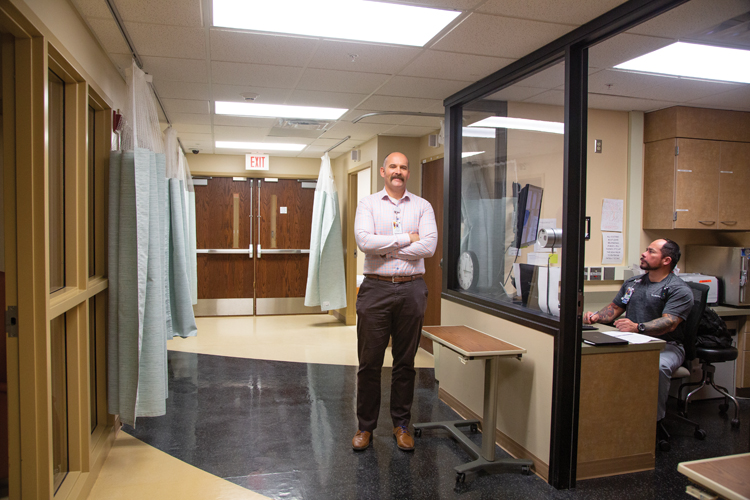
Derrick Hurst, Director for the Integrated Crisis Team, stands in the LMH space that was renovated specifically to create the safest environment possible to meet the needs of community members seeking help in the ED who are experiencing behavioral health emergencies.
UNIQUE AGENCY COLLABORATION IN KANSAS
The agencies dreamed up the collaboration for social detox, inspired by the county’s focus on improving community mental health.
“We’re all in it for the right thing. We all want to reduce medical costs and keep people with mental illness out of jail,” says Dixon of DCCCA. “The county paid us to experiment. This doesn’t happen anywhere else.”
Most of the people who use the social detox program are uninsured and in general have fewer resources. Yet, Hess says, Lawrence is a “resource-rich place,” so this collaboration begins to connect people with the resources.
“How can we make our work easier to access? There is a spirit of creativity in the county, which is cool to watch. The county has put real resources into this and has stayed involved and interested – that really isn’t something you see in other places,” Hess says.
NUMBERS TO GO BY
Already since beginning data collection in early 2018, there are statistics that help tell a story of community mental health in Douglas County.
In the LMH Emergency Department, from March to December of 2018, 71% of patients chose to be placed in detox, and 73% of those patients completed detox. From January to October of 2019, 75% of patients chose detox, and 74% of those patients completed detox. More than 200 people completed detox during those 20 months.
“We’re sending more people to social detox than we estimated. Every intervention is an opportunity; every start of recovery helps them get better. We are planting seeds that might grow into something,” Hurst says.
In general, the behavioral health unit in the Emergency Department is also being put to good use.
In 2018, there were more than 4,000 visits categorized as either mental health, substance usage or both. A little more than 10% of overall visits to the emergency room were for mental health presentation in 2018.
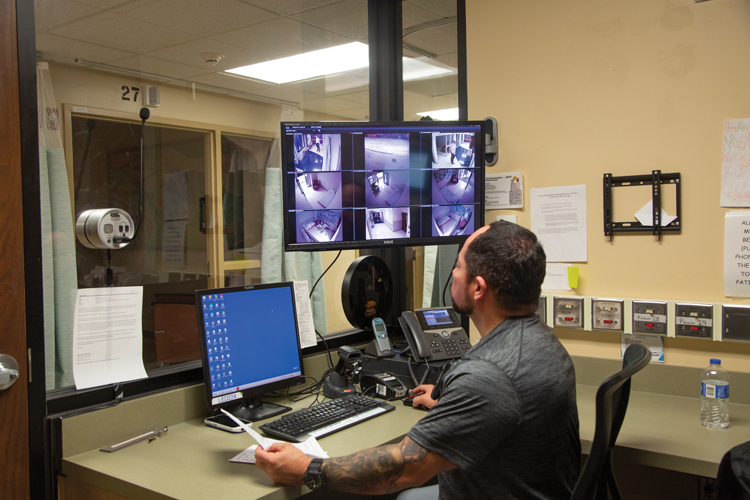
Eddie Zertuche, Emergency Department Registered Nurse. The addition of cameras allows for heightened levels of constant observation in a way that feel less intrusive then previous options without sacrificing safety.
BEHAVIORAL HEALTH CAMPUS PROGRESS
In November, construction crews broke ground to begin the housing elements of the behavioral health campus. A transitional group home with 10 beds and a 10-unit apartment complex will occupy part of the site. The group home will be for people who need short-term housing as they recover from a mental health crisis, such as medical detox, and the apartments will be longer-term housing for those who have ongoing behavioral issues.
All of the agencies agree that having stable housing is crucial for anyone with mental illness or in crisis, which is why the group home and apartments are part of the plan.
The housing is being paid for by its own collaboration of entities: city of Lawrence affordable housing funds, county funds, the Lawrence-Douglas County Housing Authority and the U.S. Department of Housing and Urban Development.
The crisis center is slated to be open around 2021 and is not yet under construction. It will have 14 beds and be open 24/7, with patients able to stay up to 14 days.
